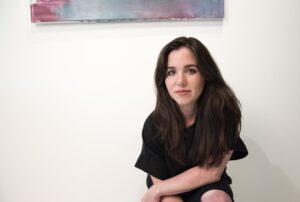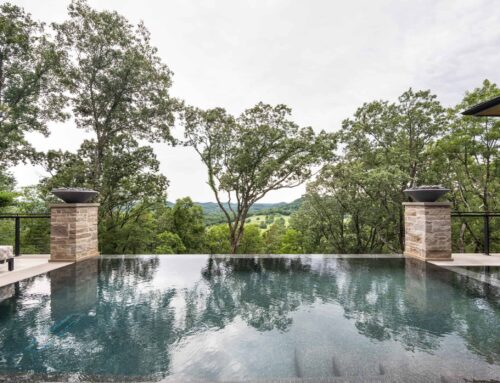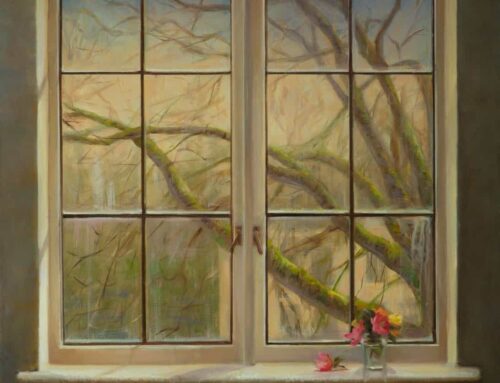Four women kick off a conversation about design, growth and inclusion
By Hollie Deese
Photography by Connie Chornuk
What started as a random thought on a Tuesday has snowballed into something much more — the idea that disparate design communities could come together to change the discourse around what a new and improving Nashville can be and could open the door for new voices to help shape how we grow as a city and community. In one week.
Fuller Hanan, a project manager with Pfeffer Torode Architecture, knew Kate O’Neil, an architect and designer with Hastings Architecture, from their work together on various committees, including with the American Institute of Architects. So when Hanan called O’Neil to run the idea of starting a citywide design week, O’Neil didn’t hesitate for a second. Neither did Lindsay DeCarlo, a co-worker of O’Neil’s at Hastings, when she ran it by her at the office.
“I was like, ‘100 percent, yes,’” DeCarlo says.
So the three of them, along with Julia Dyer, a merchandiser with VF Workwear, are pulling together the first Nashville Design Week for Nov. 8-15. It’s a multidisciplinary series of workshops, panels, discussions and site visits meant to give everyone — designers, architects, artists, makers and the public — a voice in the sometimes-difficult discussion around Nashville’s growth and how current design will affect what we leave behind.
“I hear all the time people complaining about traffic, people complaining about tall and skinnies, but they have no concept of who they could even talk to about that,” Dyer says. “And I think that Design Week can provide that opportunity to make not just literal introductions, but to also introduce the concepts of design and the know-how to push back a little bit more.”
The response to what they are trying to do has been overwhelmingly positive. Sponsors have signed on, dozens of volunteers have been organized and their call for events netted nearly 90 submissions — triple their best-case-scenario estimate.
“We all thought we’d have to convince people that there was a need for it,” DeCarlo says. “But the design community has just welcomed us with open arms.”
“Which is so Nashville,” Hanan adds.
It’s a weird mix of scary and exciting, having the pressure on them not only to have the event live up to their vision, but also to make the right choices and be open to input about how to improve on what could be a defining moment in Nashville design. All in their spare time from full-time work.
“Everyone in the public should feel that it is a completely open event,” DeCarlo says. “This is the perfect moment to pause and think, ‘Okay, how can we create artist housing with all of this new construction? How can we make sure that all of the creatives that have been able to afford and live and work and grow small businesses here are still have the opportunity to do that 10 years from now?’ And it’s not too late. We are at a moment where we can make change in that arena, and that’s, I think, why we’re all so excited to be doing this now.”
To be clear, they don’t see themselves as the voice of design. They’re just holding up the microphone for all the different communities and introducing the public to resources of which they might not have been aware. The ultimate goal is to offer programming throughout the year.
“These conversations have been happening, and the hope is that it’ll be taken to a whole different level during design week,” Dyer says, “where people get together that maybe wouldn’t normally be in a room together, in more of a relaxed atmosphere where they feel comfortable having conversations about tough topics. There’s only room for growth. There’s no limit to what we can be, while keeping our identity.”
 Julia Dyer
Julia Dyer
Julia Dyer’s family is from Cumberland County, Kentucky, but she grew up outside of Boston. Nashville was never a destination for her until her sister moved her interior design business here. Her parents followed, then Dyer after college.
Dyer, 26, works at VF Workwear as a merchandiser. Before that she was with the Nashville Fashion Alliance, which is where she met Hanan through the NFA’s work with the Nashville Civic Design Center. Dyer could see there was an overlap in their audiences, so when Hanan brought up Design Week, Dyer was all in.
She functions as the Director of Strategy and Operations for NDW, keeping all of the creative minds on track and out of rabbit holes.
“We want to explore everything, but we need to keep on a path and have a way forward. My job is to balance letting us go for those blue-sky things we want while also wrangling us in and being like, ‘Okay, guys. What can we actually accomplish?’”
For her, NDW needs to include of all the voices as neighborhoods struggle with identity and preserving culture in a quickly changing Nashville.
“Nashville is becoming more diverse. We still have a ways to go, but being able to spotlight how different each neighborhood is, and what things those neighborhoods do well, is really important so people can understand what we can be doing in that neighborhood.”
Favorite building in Nashville? “It’s in Wedgewood-Houston, whatever the street is that crosses over the railroad tracks. It used to be a shop or something, that’s been redone. But I just love that it was so intentionally redone, and it just sits alone on this corner, nothing else around it, but all four sides of it now are just, like, something you want to look at and just interact with.”
What does Nashville need? “There’s a lot of things that go into how we have become successful as a capital for tourism and a capital for music. Let’s become a capital for something else in the world, as well.”
Fuller Hanan
 Birmingham native Fuller Hanan, 32, moved to Nashville in 2014, which puts her in Music City longer than her fellow NDW founders. She left her job with Cooper Carry Architecture in Washington, D.C., when her husband took a job here and landed at Smith Gee Studio, drawn by their community-based design that focused on the public realm, like Ascend Amphitheater.
Birmingham native Fuller Hanan, 32, moved to Nashville in 2014, which puts her in Music City longer than her fellow NDW founders. She left her job with Cooper Carry Architecture in Washington, D.C., when her husband took a job here and landed at Smith Gee Studio, drawn by their community-based design that focused on the public realm, like Ascend Amphitheater.
It was a natural progression for her, then, to move to the Nashville Civic Design Center, where she spent two years as the community development manager. When Pfeffer Torode came to her with the kind of job that seemed made for her, she joined the architecture firm in April.
As Director of Programming, Hanan has been organizing the calendar of events and being sure to include people from all areas of design. It’s not an easy task to get everyone’s voice heard, especially about large-scale development that affects small-voice residents.
“We need to have influence from everyone that could touch those things, and so how do we bring people into the conversation who aren’t the most obvious and loudest groups?” she asks. “That’s something design can do with intention. It feels like a huge challenge but also a really important charge to undertake. As Design Week evolves, I hope we can keep that at the forefront of the conversation.”
Favorite building in Nashville? “I actually like the Arcade. There is always something new to find.”
What does Nashville need? “I would say preservation of place, whether that’s from residential standpoint or the downtown fabric. Not preservation for the sake of preservation, but attempting to breathe a new life into those spaces. Historic preservation is so needed and so necessary in Nashville, because otherwise we are going to just not have an identity.”
 Kate O’Neil
Kate O’Neil
Memphis native Kate O’Neil studied architecture at the University of Tennessee-Knoxville and moved to Nashville right after school, taking a job with Hastings Architecture as an architect and interior designer. Her first project with the team? The new Sounds Stadium.
“It was a really cool, very fast-paced project, but I learned a lot and loved it,” she says. “Still love going over there. It was a very fun thing to be a part of.”
She and her husband bought a home in East Nashville two years ago and have seen firsthand some of the growing pains that have come with being an “It City” that appeals to new residents as well as lots and lots of tourists.
For NDW, O’Neil is operating as Director of Development, working to make sure sponsors are paired with the right programming and connecting the different disciplines in a way that facilitates the conversation.
“I think there’s this bubbling kind of yearning for more focus and more attention to be on the people who live here and who are doing really interesting work,” she says. “If there’s anything that we can do to help shift that attention, even if it’s just for one week, and really lift each other up, we want to do that.”
Favorite building in Nashville? “That’s hard. I’ve always really loved the Bridge Building. It’s something that actually attracted me to Hastings. Just the re-use and the history of it, I think was just fascinating, and the changes that the actual building itself has gone through since it was originally constructed and the way that they were able to respect that history.”
What does Nashville need? “From a planning perspective I would love to see more of a focus on public transit. I do feel like the growth and the literal knocking together of people in this one place, it’s really hard to just get around. And as we grow, continuing to think through how we move as a city is critical.”
 Lindsay DeCarlo
Lindsay DeCarlo
Lindsay DeCarlo, 30, was considering moving from New York to take a job with Hastings Architecture when her decision was made at the Tomato Art Fest.
“I remember thinking, what is this place? And I think honestly saw an opportunity where I could make an impact in a way I didn’t feel like I could in New York. It was a change that I didn’t know I needed. Slowing down and being kinder on a daily basis — that actually feels really good.”
Her dad is a woodworker and home builder, and architecture was a love from a very early age. Despite her family’s shared love of historic homes, her parents encouraged her to go to a liberal arts school and try other things before committing to becoming an architect.
“So I studied art history and architectural history and museum studies. I thought I would go into the arts world for a while. I loved it but then realized there was no money in that world. That was a little scary to me, and so eventually I found my way back to architecture and design. I’m now doing marketing and communications for Hastings Architecture.”
It’s a good mix of creative and design that has translated well into her role as Director of Marketing for NDW, responsible for all things messaging and perception. She’s focusing on relationship-building and ensuring the message of inclusion is loud and clear. Plus making sure people outside of Nashville get an idea of what the city truly is.
“Nashville is so many different things to different people. I think the outsider’s view of Nashville is so wildly different from Nashvillians’ and the way that people who live here think about the city,” she says. “I thought I knew what Nashville was, and then the second I was here and starting to meet people, it felt so different. Being able to bring everyone together, have design be at the forefront of the world’s perception of Nashville, is really important to me.”
Favorite building in Nashville? “The Bridge Building and the pedestrian bridge. I think the city could do a lot more to hold onto its architectural history, and I very much appreciate those moments when it has been thoughtfully restored and considered and put to new use. I think adaptive reuse is something that we could be doing a lot more of.”
What does Nashville need? “My knee-jerk reaction is bike lanes. As we get more and more dense, we need to be thinking about how we move in terms of the pedestrian experience. I think that is often overlooked in our neighborhood.”
NDW 2018 Calendar of Events

Special thanks to Building No. 9 for allowing us to shoot in their Arcade location.







[…] Vadis Turner’s work during Nashville design Week at Zeitgeist Gallery. For a full listing of Nashville Design Week events, visit the calendar […]